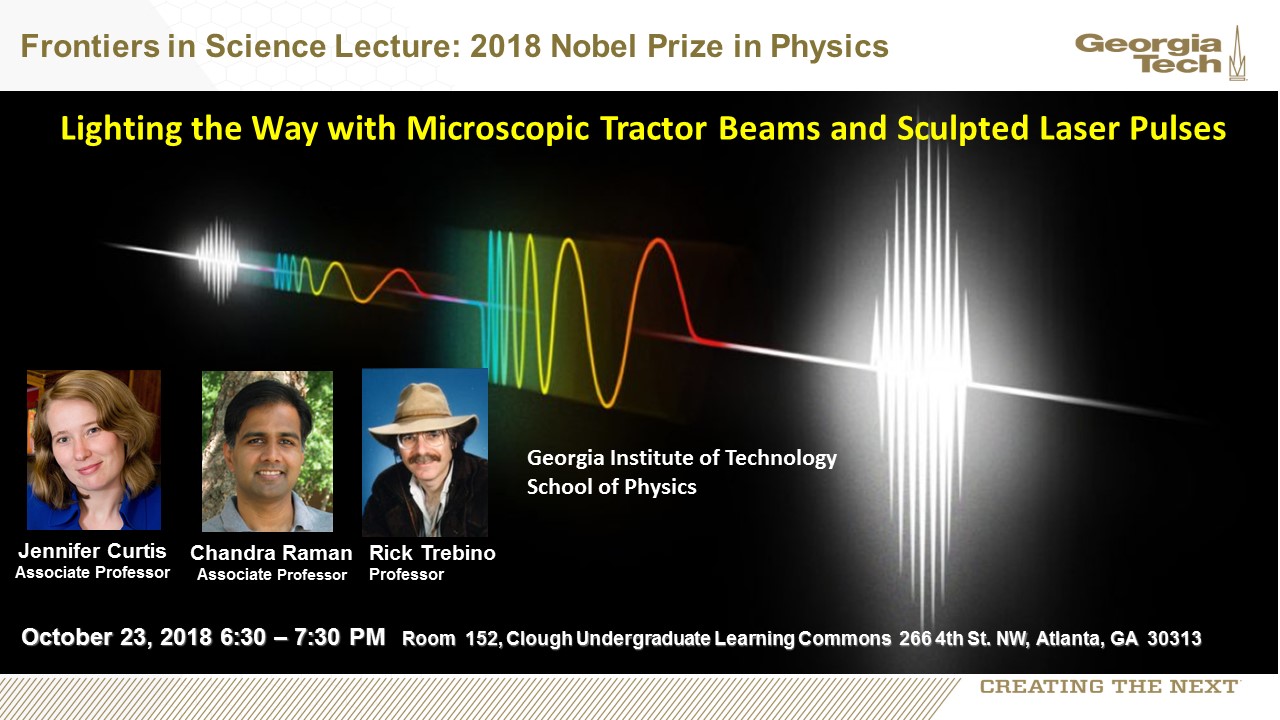Abstract
The 2018 Nobel Prize in Physics recognizes two breakthrough inventions in laser physics. The first, optical tweezers, allows scientist and engineers to use lasers like the tractor beams of Star Trek to manipulate everything from molecules to living cells. Optical tweezers have provided researchers with fingers in the microscopic world that can pull apart DNA, probe the mechanics of life, detect disease and study fundamental interactions in biology, physics, chemistry and engineering. The second breakthrough, chirped pulse amplification, enabled the construction of lasers of incredible power and precision. With the super-high power lasers came cutting-edge applications as diverse as attosecond time-resolved dynamics of atoms and molecules and laser eye surgery. In this public talk, Georgia Tech Professor Rick Trebino will give an overview of optical physics. Professors Jennifer Curtis and Chandra Raman will present a brief history of these discoveries and discuss their impacts on science and society, with an audience Q&A session afterwards.
About the Speakers
The Curtis lab, managed by Dr. Jennifer Curtis, is primarily focused on the physics of cell-cell and cell-extracellular matrix interactions, in particular within the context of glycobiology and immunobiology. Our newest projects focus on questions of collective and single cell migration in vitro and in vivo; immunophage therapy "an immunoengineering approach - that uses combined defense of immune cells plus viruses (phage) to overcome bacterial infections"; and the study of the molecular biophysics and biomaterials applications of the incredible enzyme, hyaluronan synthase.
A few common scientific themes emerge frequently in our projects: biophysics at interfaces, the use of quantitative modeling, collective interactions of cells and/or molecules, cell mechanics, cell motility and adhesion, and in many cases, the role of bulky sugars in facilitating cell integration and rearrangements in tissues.
Dr. Chandra Raman's group investigates macroscopic quantum mechanics using ultralow temperature gases—laser cooled clouds of atoms suspended inside a vacuum chamber at temperatures less than one millionth of a degree above absolute zero. We explore topics ranging from superfluidity in Bose-Einstein condensates (BECs) to quantum antiferromagnetism in a spinor condensate. Our goal is to use advanced atomic experimental techniques to illuminate contemporary phenomena in condensed matter physics, particularly in correlated quantum systems. Apart from fundamental studies, we are seeking to build cutting edge sensors that exploit the quantum properties of ultracold gases.
Rick Trebino received his B.A. from Harvard University in 1977 and his Ph.D. degree from Stanford University in 1983. His dissertation research involved the development of a technique for the measurement of ultrafast events in the frequency domain using long-pulse lasers by creating moving gratings. He continued this research during a three-year term as a physical sciences research associate at Stanford. In 1986, he moved to Sandia National Laboratories in Livermore, California, where he studied higher-order wave-mixing, nonlinear-optical perturbation theory using Feynman diagrams, and ultrashort-laser-pulse techniques with application to chemical dynamics measurements and combustion diagnostics. There he developed FrequencyResolved Optical Gating (FROG), the first technique for the measurement of the intensity and phase of ultrashort laser pulses. In 1998, he became the Georgia Research Alliance-Eminent Scholar Chair of Ultrafast Optical Physics at the Georgia Institute of Technology, where he currently studies ultrafast optics and applications. Prof. Trebino has received several prizes, including the SPIE’s Edgerton Prize, and he was an IEEE Lasers and Electro-Optics Society Distinguished Lecturer. He is a Fellow of the Optical Society of America, the American Physical Society, and the American Association for the Advancement of Science.
About The Frontiers in Science Lecture Series
Lectures in this series are intended to inform, engage, and inspire students, faculty, staff, and the public on developments, breakthroughs, and topics of general interest in the sciences and mathematics. Lecturers tailor their talks for nonexpert audiences.
Event Details
Date/Time:
-
Date:Tuesday, October 23, 2018 - 6:30pm to 7:30pm
Location:
Clough Undergraduate Learning Commons 152



